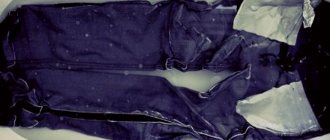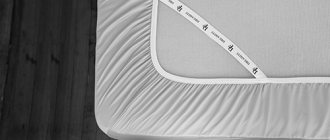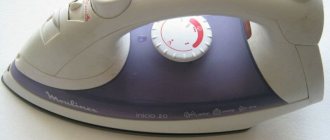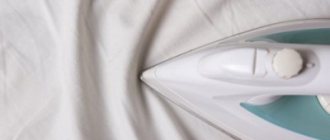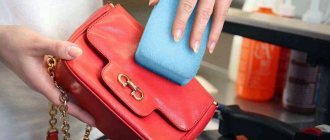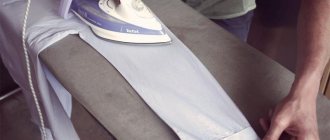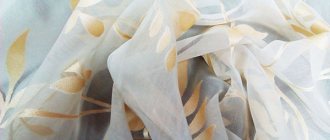If you decide to change your image a little, or change the style of some clothes that are familiar and boring to you, then, without resorting to altering the clothes, you can give it a completely different sound. The question that arises is how to effectively remove creases on trousers, freeing them from the prim, classic look.
How to remove creases on trousers so that not a trace remains of them?
If you're determined to change your clothing style, start by clearing out your wardrobe of classic, outdated pieces. If you are tired of your trousers because classic arrows annoy you, you don’t have to change your trousers, try to remove the arrow. To do this you will need an iron, ironing board, patience and caution.
Traditional trousers include creases, most styles. This design solution contributes to the visual slenderness of the legs. In brand stores, trousers are ironed in advance and creases are formed so that the buyer does not have to worry about finding the middle of the trousers on his own. But, if necessary, smoothing out creases on trousers is even easier than creating them.
Where to start removing creases on trousers?
To begin, inspect the trousers, find the manufacturer's label and read whether the manufacturer provides any specific conditions for ironing trousers and for using an iron. After that, take out the iron, lay out the ironing board and prepare a place for ironing so that nothing interferes with you from laying out the trouser legs.
Select the ironing temperature based on the recommendations on the pants label or fabric type. If you don’t know what temperature setting to choose to remove the crease on your trousers, start with a low temperature and gradually increase it, trying to iron the crease on the hem of the trouser leg to understand whether this temperature is enough or not. You can always increase the temperature, but if you choose too high a temperature setting, you will have to first remove shiny stains from ironing, and then deal with the arrows.
Common designations for ironing modes for trousers
An iron with several symbols is usually drawn on the product tag, which can be used to determine how to properly iron the product.
If the label shows an iron with three dots, then you can iron a linen or cotton product using temperatures up to 200 degrees. To smooth out creases on such trousers better, faster and easier, you need to slightly wet the pant leg where creases form and smooth out the creases until they dry.
If the label shows an iron surrounded by dots that form a circle, this indicates that the arrow on the trousers can be removed at a temperature not exceeding 140 degrees.
An iron with two points means that we have a product made of cotton, polyester, wool or polyester. This product can be ironed at temperatures up to 130 degrees.
If there is one dot on the iron, then the ironing temperature should not exceed 120 degrees. Such designations are typically used for trousers made of viscose, nylon, nylon, polyamide, polyacrylic or acetate.
What you need to know
To remove the arrows, you will need an iron and ironing board, as well as a little time and patience. First, you need to find a label on the fabric with information from the manufacturer about the intended washing and ironing conditions. The label has the following symbols:
- The three-point iron allows ironing at temperatures starting from 200°C.
- Two points allow heating to no more than 150°C.
- One point recommends not to exceed 110°C.
- The image of crossed out steam from the iron allows you to iron only without steam.
If there is no label, start with minimal heat, gradually starting to increase the temperature. You cannot iron a product at a high temperature; the fabric can be damaged; at best, stains will appear from areas ironed at a high temperature.
If it doesn't smooth out
A problem may arise with smoothing out old arrows that remain even after proper processing. If the fabric allows ironing with steam, the problem can be solved easily and quickly:
- The trousers must be thoroughly moistened with water and the trouser leg laid out on an ironing board.
- Hot steam is released over the desired place, after which the iron rises, and a book or other suitable object must be placed in its place.
- Pressing a kind of press with your hand, hold for 20-30 seconds.
The method is effective because the press, after treatment with hot steam, does not allow the fabric to take the shape of an arrow.
How to iron trousers with arrows
Trousers with arrows require careful care and proper ironing. To do this, the folds need to be ironed using an iron or a steam generator, an ironing iron (gauze, special fabric). If the device does not have a steaming function, then a spray bottle with clean water can successfully replace it.
How to iron classic trousers with arrows
How to iron dress pants correctly? After the small parts of the product have been ironed, the trousers are folded together on the surface, the internal and side seams are aligned, and then the upper trouser leg is folded back. Then carefully and carefully iron the spread part, not forgetting about the wet mode and the iron if there is no overhead sole. Instead of an iron, you can use a steam generator, but the trousers should still be in a horizontal position.
Simple ironing and steaming does not guarantee long-term preservation of shape; on the contrary, the sharpness of the angle on the fold of the fabric is smoothed out quite quickly. To keep the arrow in place, you must use a press. Do not be upset if such a device is not available in the arsenal of home appliances - no one except seamstresses has it. A thick book will perfectly fulfill the role of a press. They do this by following a step-by-step algorithm:
- spread a damp cloth on the canvas and iron it;
- Having removed the iron, immediately place a book volume in its place and hold it for about 30 seconds;
- While the book is lying, iron the next part of the canvas, and then move the book.
In this way, all the arrows will be ironed, and after steaming with the help of an improvised press, they will hold the angle much longer and more clearly. Synthetics do not need steam treatment - the fabric already holds folds perfectly.
How to iron out the top of your trousers
Clean trousers are carefully laid out on the surface of an ironing board or table - it is preferable to use a board. It is necessary to conduct a visual inspection of the product, pay attention to the condition of the seams, pockets, belt loops, bottom hems, and identify places that require special attention:
- If the seams are wrinkled on the wrong side, then they are ironed first - it is advisable that there is some kind of backing between the panels of the trouser leg at this time - this will protect the front side from the imprint of the cuts.
- Then they iron the burlap of the pockets, not forgetting to set the required temperature. Burlap can be made of twill or cotton lining fabric, and different modes are set for them.
- After this, iron the hem at the bottom and turn the product right side out.
Next, the codpiece and belt are ironed, making sure that each part remains in perfect condition. It is most convenient to do this on the tapered end (tongue) of the ironing board - this is one of the most difficult operations, and the back should not touch the front. Trousers are always ironed from top to bottom.
We recommend:
What to do if no steam comes out of your handheld steamer
How to secure folds
There are a couple of techniques that will not only help you complete the task of ironing trousers with creases more efficiently, but also consolidate the result. To do this you will need starch and a piece of soap:
- Rub the arrows from the wrong side with laundry soap, after which they are ironed from the front;
- to give special rigidity to the creases in the upper part of the trousers, they are lubricated with a liquid paste made from starch and ironed in the same way as in the case of soap.
Apple cider vinegar does not play a role in the preservation of the arrows, but, previously diluted in water in a proportion of 1 tbsp. l. per 1 liter of water, it will help avoid shine on the surface of textiles. After ironing, the trousers must dry, otherwise all the work will be wasted.
Where to begin?
Before you start ironing, study the composition of the fabric, this will help you avoid mistakes and ruin your trousers . On the label, the manufacturer indicates the content of a certain fabric in the product. It looks like this: 80% cotton, 20% polyester. That is, this model contains both synthetic and natural fibers, while there are more of the latter threads in the trousers.
What you need to know about fabric?
Depending on the composition of the fabric, you need to set the temperature and a certain ironing mode. For example, it is recommended to process synthetics only with a warm iron, jersey can only be ironed through damp gauze, and wool must be ironed from the reverse side at a temperature not exceeding 165 degrees. Lining fabric requires ironing from the inside out without using steam or dampening.
IMPORTANT! Always start ironing your item at a low temperature on a small area near the edge, so you will understand which ironing method is suitable for this item.
Required Tools
In order to remove creases on trousers, you need to have an iron and an ironing board on hand (the latter can be replaced with a flat, hard surface). You may also need damp gauze or a thin cloth. If the iron does not have a built-in water sprinkler, clean water and a spray bottle will be an indispensable assistant. Most modern irons are equipped with a steamer, but if your assistant does not have such a function, you will need a pan of boiling water.
What ironing modes are there?
Depending on the type of fabric, there are several ironing modes:
- dry;
- wet;
- using steam.
Dry mode is suitable for trousers made of cotton or linen. Dry mode is not suitable for wool products. Damp or wet ironing is suitable for almost all types of fabric. The process occurs by spraying water on the item itself or using damp gauze. Some fabrics need to be steamed. There is a small nuance here. For example, wool trousers must be steamed from the reverse side, otherwise the fabric will begin to shine and shine .
IMPORTANT! Before ironing, be sure to read the label; some items cannot be ironed.
Which temperature mode should you choose?
On the label, the manufacturer indicates symbols that will tell you which temperature regime is suitable for a particular product. Let's look at the most common options:
- an iron with steam crossed out above it means that the use of steam when ironing is prohibited;
- an iron and one dot symbolize low temperature - up to 100 degrees;
- the iron and two dots indicate that the permissible ironing temperature is not higher than 150 degrees;
- an iron with three points allows you to set the temperature up to 200 degrees;
- A crossed out iron does not allow the use of an iron on the product.
Features of the procedure for natural, artificial and synthetic fabrics
Each item on its reverse side has a factory tag from the manufacturer indicating the exact composition of the fabric. You should carefully study what the material of the trousers is made of. After this, you need to select the ironing mode suitable for this type of fabric. This is a very important point, because the wrong temperature or ironing technique can not only ruin the crease, but also deteriorate the entire appearance of the trousers.
First of all, you need to adjust the temperature of the iron according to the type of fabric:
- flax – 180–200°C;
- cotton – 140–170°С;
- polycotton - about 110°C;
- wool and wool mixture – from 100 to 140°C;
- viscose – about 120°C.
Modern models of irons are equipped with a steam function, which significantly improves the quality of ironing and facilitates the process itself. However, in addition to steam, it is advisable to iron most fabrics through a damp cloth. This is especially true for materials with a fleecy or matte surface and various types of synthetics.
Stages of smoothing out arrows
You should start by cleaning or washing your trousers. The item must be clean from dirt, lint, and dust. Pockets must be empty. Once you are sure that the trousers can be ironed, proceed to the stage of smoothing out the creases.
- Carefully lay the product on an ironing board or other flat and hard surface (table, cabinet, etc.). The pants are ironed one at a time. The arrow should be exactly in the middle of the trouser leg.
- Wet the cloth or gauze with water and place it on the iron, set the iron to the acceptable temperature setting and start ironing.
- Iron the arrow until the wet gauze dries and the arrow disappears. Be careful not to overheat the fabric. It is better to wet the gauze again and repeat the process. If your trousers can be ironed with steam, use this mode, this will make the job easier and the creases will disappear faster.
There is no particular difference in which direction to iron the trousers, but moving from the edge of the trouser leg to the top, that is, to the waistband, is more convenient. There is no need to iron the entire arrow at once; work with small sections of 10–15 cm, gradually moving the wet gauze.
IMPORTANT! If you are afraid of ruining your trousers, iron the product from the inside out.
Extending the life of shooters
After the trousers and creases have been ironed, the first wash will “kill” all the work. To save your work for a long time, you need not only to know how to properly iron trousers with creases, but also how to preserve them.
Folk remedies will help preserve your arrows for a long time
To prolong the life of the shooter, they use folk remedies, the price of which is pennies.
Remedy 1. Soap
Laundry soap will extend the life of shooters
- Take a piece of laundry soap or soap and draw it from the wrong side along the arrows.
- After this, all that remains is to iron the women's or men's trousers from the front side.
Remedy 2. Starch
Starch will preserve the arrows for a long time
Those places where the arrows do not stick well can be greased with starch paste. We wait for this mixture to dry completely, and only then iron the front side.
Remedy 3. Vinegar
Vinegar will additionally fix the ironing result.
So:
- Prepare a solution of vinegar and water. Take 1 tablespoon of vinegar and dilute it in 1 liter of water.
- We wet the cotton fabric in this solution. We place it on the trousers and iron it.
- I do not recommend putting on trousers after ironing. Let them cool for 5-7 minutes, so they won’t wrinkle longer.
- If you iron in advance, then you should store it either in the closet on a hanger, hanging it, not folding it.
After ironing, trousers should be allowed to cool down.
What to do if they still don’t smooth out?
If the creases on the trouser legs are not smoothed out, and this often happens with old, stale or overly pressed clothes, you can use a press. Any hard, heavy object with a smooth surface, such as a book or a wooden block, can be used as a press.
Lay the trouser leg on an ironing board, cover the crease with damp gauze, and smooth it using steam. As soon as the iron releases steam on the fabric, lift it and place a press on the arrow. Press it with your hand and hold for 15–20 seconds. Repeat the maneuver throughout the entire product. This method will not allow the fibers of the fabric to take their previous shape.
IMPORTANT! Using a wooden block as a press, inspect it for splinters and chips to avoid damaging your clothing.

